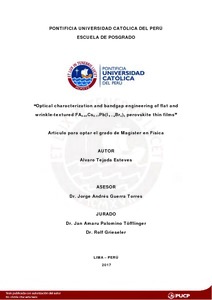| dc.contributor.advisor | Guerra Torres, Jorge Andrés | |
| dc.contributor.author | Tejada Esteves, Alvaro | es_ES |
| dc.date.accessioned | 2018-03-26T15:06:10Z | es_ES |
| dc.date.available | 2018-03-26T15:06:10Z | es_ES |
| dc.date.created | 2017 | es_ES |
| dc.date.issued | 2018-03-26 | es_ES |
| dc.identifier.uri | http://hdl.handle.net/20.500.12404/11718 | |
| dc.description.abstract | Los índices de refracción complejos de películas delgadas de perovskitas de haluros mixtos de formamidinio-cesio de plomo (FA0.83Cs0.17Pb(I1 − xBrx)3), con composiciones variando de x = 0 a 0.4, y para topografías planas y de textura rugosa, son reportadas. Las películas se caracterizan por medio de una combinación de elipsometría espectral de ángulo variable y transmitancia espectral en el rango de longitudes de onda de 190 nm a 850 nm. Las constantes ópticas, espesores de las películas y las capas de microrugosidad, son determinadas con un método “punto a punto”, minimizando una función de error global, sin hacer uso de modelos de dispersión, e incluyendo información topográfica proporcionada por un microscopio con focal láser. Para evaluar el potencial de ingeniería del ancho de banda del material, sus anchos de banda y energías de Urbach son determinadas con exactitud haciendo uso de un modelo de fluctuaciones de banda para semiconductores directos. Este considera las colas de Urbach y la región de absorción banda a banda fundamental en una sola ecuación. Con esta información, la composición que brindaría el ancho de banda óptimo de 1.75 eV para una celda solar tándem Siperovskita es determinada. | es_ES |
| dc.description.abstract | The complex refractive indices of formamidinium cesium lead mixed-halide (FA0.83Cs0.17Pb(I1 − xBrx)3) perovskite thin films of compositions ranging from x = 0 to 0.4, with both flat and wrinkle-textured surface topographies, are reported. Films are characterized using a combination of variable angle spectroscopic ellipsometry and spectral transmittance in the wavelength range of 190 nm to 850 nm. Optical constants, film thicknesses and roughness layers are obtained point-by-point by minimizing a global error function, without using optical dispersion models, and including topographical information supplied by a laser confocal microscope. To evaluate the bandgap engineering potential of the material, the optical bandgaps and Urbach energies are then accurately determined by applying a band fluctuations model for direct semiconductors, which considers both the Urbach tail and the fundamental band-to-band absorption region in a single equation. With this information, the composition yielding the optimum bandgap of 1.75 eV for a Si-perovskite tandem solar cell is determined. | es_ES |
| dc.language.iso | eng | es_ES |
| dc.publisher | Pontificia Universidad Católica del Perú | es_ES |
| dc.rights | info:eu-repo/semantics/openAccess | es_ES |
| dc.rights.uri | http://creativecommons.org/licenses/by-nc-nd/2.5/pe/ | * |
| dc.subject | Óptica | es_ES |
| dc.subject | Películas delgadas | es_ES |
| dc.subject | Perovskita | es_ES |
| dc.title | Optical characterization and bandgap engineering of flat and wrinkle-textured FA0.83 Cs0.17 Pb(I1 − xBrx)3 perovskite thin films | es_ES |
| dc.type | info:eu-repo/semantics/masterThesis | es_ES |
| thesis.degree.name | Maestro en Física | es_ES |
| thesis.degree.level | Maestría | es_ES |
| thesis.degree.grantor | Pontificia Universidad Católica del Perú. Escuela de Posgrado | es_ES |
| thesis.degree.discipline | Física | es_ES |
| renati.advisor.dni | 46163725 | |
| renati.discipline | 533017 | es_ES |
| renati.level | https://purl.org/pe-repo/renati/level#maestro | es_ES |
| renati.type | http://purl.org/pe-repo/renati/type#tesis | es_ES |
| dc.publisher.country | PE | es_ES |
| dc.subject.ocde | https://purl.org/pe-repo/ocde/ford#1.03.00 | es_ES |






